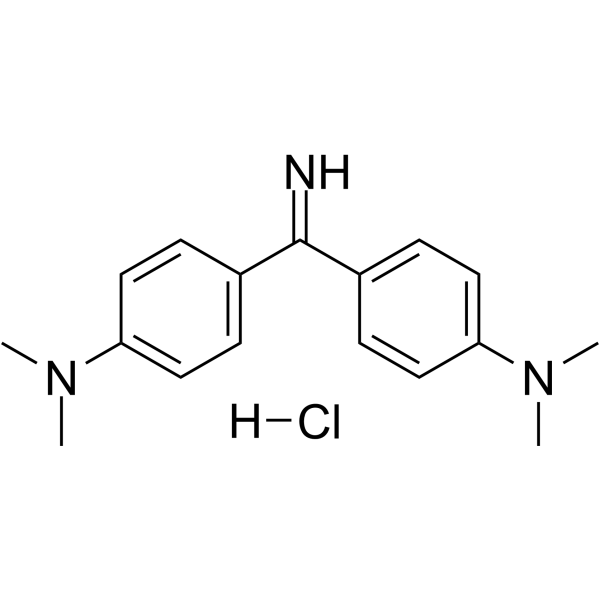Auramine O

Auramine O structure
|
Common Name | Auramine O | ||
|---|---|---|---|---|
| CAS Number | 2465-27-2 | Molecular Weight | 303.830 | |
| Density | 1.01g/cm3 | Boiling Point | 406.2ºC at 760mmHg | |
| Molecular Formula | C17H22ClN3 | Melting Point | >250 °C (dec.)(lit.) | |
| MSDS | Chinese USA | Flash Point | 199.4ºC | |
| Symbol |


GHS06, GHS08 |
Signal Word | Danger | |
Use of Auramine OAuramine O is a yellow fluorescent dye and can be used to stain acid-fast bacteria. Auramine O is toxic and resistant in the environment[1][2]. |
| Name | auramine O |
|---|---|
| Synonym | More Synonyms |
| Description | Auramine O is a yellow fluorescent dye and can be used to stain acid-fast bacteria. Auramine O is toxic and resistant in the environment[1][2]. |
|---|---|
| Related Catalog | |
| References |
| Density | 1.01g/cm3 |
|---|---|
| Boiling Point | 406.2ºC at 760mmHg |
| Melting Point | >250 °C (dec.)(lit.) |
| Molecular Formula | C17H22ClN3 |
| Molecular Weight | 303.830 |
| Flash Point | 199.4ºC |
| Exact Mass | 303.150238 |
| PSA | 30.33000 |
| LogP | 4.13650 |
| Vapour Pressure | 8.31E-07mmHg at 25°C |
CHEMICAL IDENTIFICATION
HEALTH HAZARD DATAACUTE TOXICITY DATA
MUTATION DATA
|
| Symbol |


GHS06, GHS08 |
|---|---|
| Signal Word | Danger |
| Hazard Statements | H302-H311-H351 |
| Precautionary Statements | P280-P312 |
| Hazard Codes | T:Toxic |
| Risk Phrases | R22;R24;R40 |
| Safety Phrases | S36/37-S45 |
| RIDADR | UN 2811 6.1/PG 3 |
| WGK Germany | 3 |
| RTECS | BY3675000 |
| Hazard Class | 6.1 |
| HS Code | 2925290090 |
| HS Code | 2925290090 |
|---|---|
| Summary | 2925290090 other imines and their derivatives; salts thereof。Supervision conditions:None。VAT:17.0%。Tax rebate rate:9.0%。MFN tariff:6.5%。General tariff:30.0% |
|
Functional and genetic characterization of the tap efflux pump in Mycobacterium bovis BCG.
Antimicrob. Agents Chemother. 56(4) , 2074-83, (2012) Efflux pumps extrude a wide variety of chemically unrelated compounds conferring multidrug resistance and participating in numerous physiological processes. Mycobacterium tuberculosis possesses many e... |
|
|
Confocal laser scanning microscopy elucidation of the micromorphology of the leaf cuticle and analysis of its chemical composition.
Protoplasma 252 , 1475-86, (2015) Electron microscopy techniques such as transmission electron microscopy (TEM) and scanning electron microscopy (SEM) have been invaluable tools for the study of the micromorphology of plant cuticles. ... |
|
|
Efficacy of real-time polymerase chain reaction for rapid diagnosis of endobronchial tuberculosis
Int. J. Infect. Dis. 27 , 13-7, (2014) • We assess the efficacy of realtime PCR of bronchial biopsies for diagnosis of EBTB • Real-time PCR yields better than AFB staining of bronchial brushing or sputum smear • Bronchoscopic types of EBTB... |
| Hydrogen chloride - 4,4'-carbonimidoylbis(N,N-dimethylaniline) (1:1:1) |
| Auramine Extra |
| Auramine O [Dye Content |
| Basic Yellow 2 |
| MFCD00012484 |
| Auramine Pure |
| Auramine N |
| Auramine O |
| Benzenamine, 4,4'-carbonimidoylbis[N,N-dimethyl-, chloride, hydrogen salt (1:1) |
| AURAMINE HYDROCHLORIDE |
| Aizen auramine |
| EINECS 219-567-2 |
| Pyoctaninum aureum |
| AURAMINE |
| Benzenamine, 4,4'-carbonimidoylbis[N,N-dimethyl-, monohydrochloride |
| 4,4′-(Imidocarbonyl)bis(N,N-dimethylaniline) monohydrochloride |
| 4-[4-(dimethylamino)benzenecarboximidoyl]-N,N-dimethylaniline,hydrochloride |
| C.I. Basic Yellow 2 |
| Auramine Yellow |
| Auramine O,biological stain |
| CI Basic Yellow 2 |
| Auramin |

